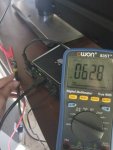I also find this very interesting. I was a "construction" guy, so I did not get into theory a lot and never really used a scope, so you guys are playing above my education level.
In my uneducated mind, I don't see how having some minor DC voltages or a somewhat distorted wave form can cause lights to burn out, that seems more of over voltage issues that can easily be caused by a deteriorated neutral conductor. Your 50 amp one line load test seems to have ruled that out.
Have you ever been able to recreate the big neutral imbalance that you showed with the 3 meters in some of the early pictures, or is that a one time occurence?
Jhard13, please do not take this the wrong way, just like I'm hung up on a neutral issue somewhere (could be in the PoCo distribution lines) you seem to be hung up on wave forms. That seems to be your area of experience and you may be looking so hard at that, that you miss other signs.
In keeping with my tunnel vision,

, how did you put that 50-amp 120-volt load on one phase? Curious, that's a pretty heavy load and I don't know how I could do that, or was that the PoCo doing it with
their "beast" meter insert?


